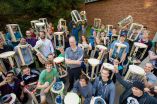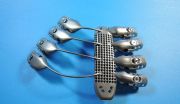INFORMATION:
Stellar discovery by Queen's researcher
Ph.D. candidate discovers massive binary star with unique properties
2015-09-11
(Press-News.org) PhD candidate Matt Shultz has discovered the first massive binary star, epsilon Lupi, in which both stars have magnetic fields. A binary star is a star system consisting of two or more stars, orbiting around their common centre of mass.
For the past few years, the BinaMIcS (Binarity and Magnetic Interactions in various classes of Stars) collaboration, formed to study the magnetic properties of close binaries, has been trying to find such an object. They have now discovered one using the Canada-France-Hawaii Telescope.
"The origin of magnetism amongst massive stars is something of a mystery," says Mr. Shultz (Physics, Engineering Physics and Astronomy), "and this discovery may help to shed some light on the question of why these stars have magnetic fields."
In cool stars, such as the Sun, magnetic fields are generated by a convection in the outer portion of the star. However, there is no convection in the outer layers of massive star, so there is no support for a magnetic dynamo. Nevertheless, approximately 10 per cent of massive stars have strong magnetic fields.
Two explanations have been proposed for the origin of massive star magnetic fields, both variants on the idea of a so-called "fossil" magnetic field, which is generated at some point in the star's past and then locked in to the star's outer portion.
The first hypothesis is that the magnetic field is generated while the star is being formed; the second is that the magnetic field originates in dynamos driven by the violent mixing of stellar plasma when the two stars in a close binary merge.
"This discovery doesn't change the basic statistics that the BinaMIcS collaboration has assembled," says Mr. Shultz, "and we still don't know why there are so few magnetic, massive stars in close binaries."
The research shows the strengths of the magnetic fields are similar in the two stars, however, their magnetic axes are anti-aligned, with the south pole of one star pointing in approximately the same direction as the north pole of the other.
"We're not sure why that is yet, but it probably points to something significant about how the stars are interacting with one another. We'll need to collect more data."
The research was published in the Monthly Notices of the Royal Astronomical Society.
ELSE PRESS RELEASES FROM THIS DATE:
UK researchers find 'dormant' parasite cysts are actually quite active
2015-09-11
LEXINGTON, Ky. (Sept. 8, 2015) -- A new University of Kentucky study in the journal mBio shows that tissue cysts of the parasite Toxoplasma gondii, long thought to be dormant, are quite active.
Led by Anthony Sinai, professor at the UK College of Medicine, the study has significant implications on the understanding of chronic toxoplasmosis in the brain, a condition suggested to contribute to a range of neurological diseases including schizophrenia in humans, and the modulation of behavior in rodents.
Toxoplasmosis can be acquired from the droppings of infected cats ...
Extreme pressure causes osmium to change state of matter
2015-09-11
Using metallic osmium (Os) in experimentation, an international group of researchers have demonstrated that ultra-high pressures cause core electrons to interplay, which results in experimentally observed anomalies in the compression behavior of the material.
Os is one of Earth's most exceptional elemental materials, possessing the highest known density at ambient pressure, one of the highest cohesive energies and melting temperatures, and an incompressibility that is almost comparable to that of diamond.
Researchers believe that the ability to affect core electrons ...
Making a difference with open source science equipment
2015-09-11
Open source lab equipment is the focus of a new study, published in Science and Public Policy. Joshua Pearce, an associate professor of materials science and engineering as well as electrical and computer engineering at Michigan Tech, led the research. Pearce proposes that instead of spending millions of dollars every year replacing quickly obsolescent equipment, that money could be redirected to developing open source tools that are "upgradeable and transformable--they will be continuously updated" using digital manufacturing techniques such as 3-D printing.
The benefits ...
Inside climate politics
2015-09-11
The politics of climate change are often depicted as a simple battle, between environmentalists and particular industries, over government policy. That's not wrong, but it's only a rough sketch of the matter. Now a paper co-authored by MIT economist Christopher Knittel fills in some important details of the picture, revealing an essential mechanism that underlies the politics of the climate battle.
Specifically, as Knittel and his colleagues demonstrate, at least one climate policy enacted by Congress -- on transportation fuels -- contains a crucial asymmetry: It imposes ...
Study reveals connection between fitness level, brain activity, and executive function
2015-09-11
The aging process is associated with declines in brain function, including memory and how fast our brain processes information, yet previous research has found that higher levels of cardiorespiratory fitness in older adults leads to better executive function in the brain, which helps with reasoning and problem solving. Higher cardiorespiratory fitness levels have also been found to increase brain volume in key brain regions.
A new study from a team at the Beckman Institute for Advanced Science and Technology at the University of Illinois reveals the connection between ...
Best precision yet for neutrino measurements at Daya Bay
2015-09-11
UPTON, NY--In the Daya Bay region of China, about 55 kilometers northeast of Hong Kong, a research project is underway to study ghostlike, elusive particles called neutrinos. Today, the international Daya Bay Collaboration announces new findings on the measurements of neutrinos, paving the way forward for further neutrino research, and confirming that the Daya Bay neutrino experiment continues to be one to watch.
The latest findings involve measurements that track the way neutrinos change types or flavors as they move, a characteristic called neutrino oscillation. By ...
Scientists learn how to predict plant size
2015-09-11
VIB and UGent scientists have developed a new method which allows them to predict the final size of a plant while it is still a seedling. Thanks to this method, which is based on the knowledge that a set of genes is associated with the final size of a leaf, scientists will be able to significantly accelerate plant breeding programs. The VIB/UGent scientists were able to identify this set of genes through advanced and highly detailed analyses. Expression analysis of specific genes will help breeders select the most useful crossing products at a very early stage.
Smart ...
Down but not out -- inhibited Tyk2 retains anti-cancer activity
2015-09-11
Tyrosine kinase 2 (Tyk2) is an enzyme involved in intracellular signalling and has an important role in activating the immune system. But enzymatically active Tyk2 can also promote excessive immune reactions and growth of certain cancer types.
Since several years, scientists are developing substances to specifically inhibit the kinase activity of Tyk2 for the treatment of inflammatory diseases and for potential use in cancer therapy. However, complications may occur: Tyk2 crucially contributes to the maturation and activation of natural killer (NK) cells. NK cells form ...
Cancer patient receives 3-D printed ribs
2015-09-11
After being diagnosed with a chest wall sarcoma, a 54-year-old Spanish man's surgical team made the decision to remove his sternum and a portion of his rib cage and replace it with an implant.
The implant was designed and manufactured by medical device company, Anatomics, who utilised the CSIRO's 3D printing facility, Lab 22 in Melbourne, Australia.
The surgical team, Dr José Aranda, Dr Marcelo Jimene and Dr Gonzalo Varela from Salamanca University Hospital, knew the surgery would be difficult due to the complicated geometries involved in the chest cavity.
The ...
Wavelets improve medical imaging
2015-09-11
An approach to converting the data from MRI (magnetic resonance imaging) machines, mammograms and other medical equipment gives doctors a much clearer picture of your insides and a chance to detect disease and other problems earlier, according to research published in the International Journal of Biomedical Engineering and Technology. The technique known as the wavelet transform was first reported in 1910, but it was during the early 1990s that its applications in medicine and biomedical research first emerged and it is now reaching maturity as a technique to supplement ...
LAST 30 PRESS RELEASES:
Uterine fibroids linked to elevated heart disease risk
Dual use of cigarettes and vapes can reduce risks of smoking and help smokers quit
New bioelectronics device based on hydrogel- elastomer conductive nanomembranes
More yield through heterosis: IPK research team decodes gene interaction
James Webb telescope reveals spectacular atmospheric escape
ICE-CSIC leads a pioneering study on the feasibility of asteroid mining
Dramatic rise in young people using mental health services
Be careful trusting TikTok for gout advice
A study by the University of Seville links the vanishing of the specific heats at absolute zero with the principle of entropy increase
Anxiety and insomnia may lower natural killer cell count, potentially repressing immune function
How parasitic, asexual plants evolve and live
Research spotlight: A subset of patients with depression could benefit from anti-inflammatory treatment
New fully digital design paves the way for scalable probabilistic computing
Membrane electrode assembly design for high-efficiency anion exchange membrane water electrolysis
U.S. debt ceiling disputes show measurable impact on global crude oil markets
Climate extremes triggered rare coral disease and mass mortality on the Great Barrier Reef
Direct observation reveals “two-in-one” roles of plasma turbulence
Humans rank between meerkats and beavers in monogamy ‘league table’
US fossil reveals early mass-burial event and ancient microbial attack
Sedative choice could improve outcomes for breathing tube patients
New superconducting thin film for quantum computer chips
Simulations reveal protein "dynamin" constricts cell membranes by loosening its grip
Nearly 1 in 5 UK emergency department patients cared for in corridors/waiting rooms
Heavy energy drink intake may pose serious stroke risk, doctors warn
Violence against women and children among top health threats: New global study reveals disease burden far larger than previously estimated
Predicting who is at risk of developing type 1 diabetes, as new drugs now available
New gene-mapping method unlocks hidden drivers of cancer
Ocean current and seabed shape influence warm water circulation under ice shelves
Call to increase funding for ‘invisible’ Deaf victim-survivors of domestic abuse
University of Maryland School of Medicine names distinguished scientist and academic leader Gerald M. Wilson, PhD, as Chair of the Department of Biochemistry and Molecular Biology
[Press-News.org] Stellar discovery by Queen's researcherPh.D. candidate discovers massive binary star with unique properties


